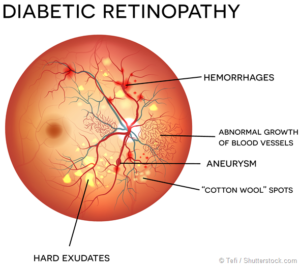
Diabetic retinopathy can develop when a patient living with type 2 diabetes mellitus (T2DM) has high blood sugars that damage the blood vessels in the retina, a part of the eye that’s critical to helping the brain form images that help make sense of the visible world.
There are two types of diabetic retinopathy: nonproliferative and proliferative.
In nonproliferative diabetic retinopathy, high blood sugars lead to a weakening of the walls of the blood vessels in the retina.
In proliferative diabetic retinopathy, the injured blood vessels eventually stop working, and new blood vessels form. But these new blood vessels don’t work very well, either, as they can be prone to leaking. The growth of these new blood vessels can lead to the retina becoming detached, which can lead to other vision issues, including vision loss. Moreover, the newly-formed blood vessels can increase the risk of developing glaucoma.
Diabetic retinopathy can cause a range of symptoms, whether it’s blurry vision, an inability to distinguish between colors, or vision loss. But symptoms generally don’t emerge very quickly, which is why patients living with T2DM are advised to see an eye physician (ophthalmologist) on a regular basis for eye exams that can help detect the presence of diabetic retinopathy.
The longer one has type 2 diabetes, the greater the risk becomes of developing diabetic retinopathy. And higher blood sugars tend to be associated with a higher risk of developing diabetic retinopathy.
Not everyone with type 2 diabetes will develop diabetic retinopathy. But for folks living with type 2 diabetes, keeping blood sugars under good control can help prevent severe vision loss, and even slow progression of retinopathy. Quitting smoking can also help lower one’s risk, as can keeping one’s blood pressure in a healthy range. In the event that severe diabetic retinopathy develops, a number of treatments can help. The optimal treatment option is chosen based on the specific features of one’s retina.
To find out more about treatments for eye conditions visit our Website here: http://cosmoseyecare.in/ or will like to book an appointment, visit us at our clinic today. Or you can call us at +91-9599229744 for booking an appointment.

Leave a Reply